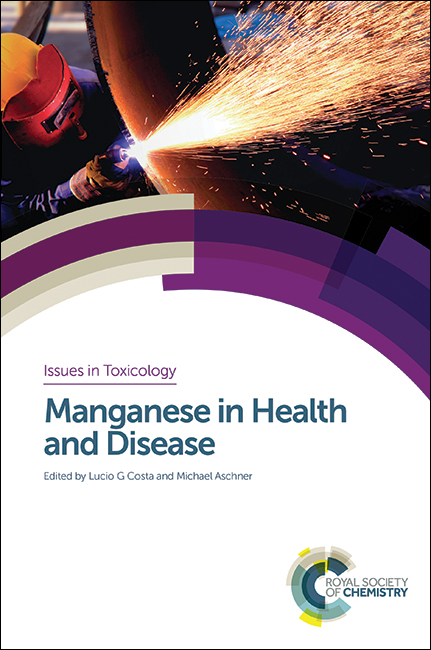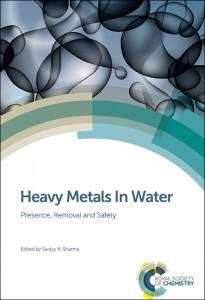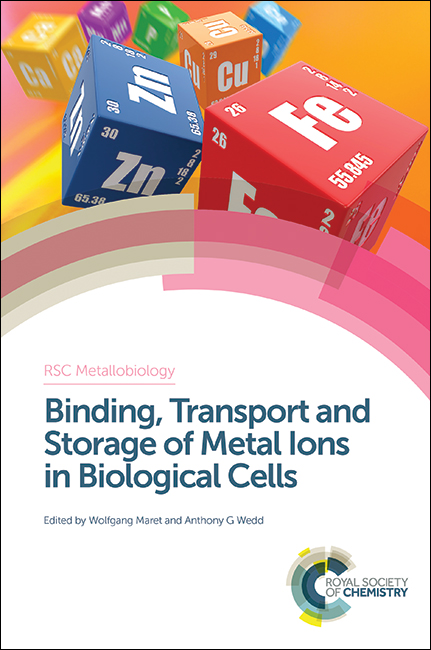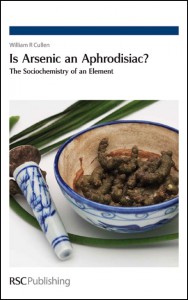Take a look at our publications surrounding metals in health. These particular books are taken from across several of our series and complement each other well. This is just a snapshot of the books which are currently available and so if you can’t find what you need then we would recommend visiting our online bookshop in order to find other similar titles.

Manganese in Health and Disease
Lucio Costa (Editor), Michael Aschner (Editor)
RSC Issues in Toxicology series
Manganese in the diet is nutritionally essential for normal physiologic functioning. However, excessive exposure to manganese has been associated with developmental, neurodegenerative and other disorders. The book comprehensively covers the toxicology of manganese. Leading investigators provide perspectives from toxicology, neuroscience, nutrition, molecular biology and risk assessment disciplines and chapters cover the toxicokinetics, toxicodynamic interactions and health effects of manganese, as well as its potential role in neurodegenerative diseases. A large section devoted to health effects presents the latest research that associates manganese exposure to potential human diseases. Any scientists, health professional or regulator involved with metal exposure and toxicology should find this volume essential reading. Students and researchers in neurotoxicology will also find this book a useful reference.

Alan B. G. Lansdown (Author)
RSC Issues in Toxicology series
This book re-evaluates epidemiological and occupational health studies, experimental studies in animals and in vitro experiments relating to the toxicity of 27 metal and metalloid elements for which evidence of carcinogenicity has been presented. Human carcinogenic risk is substantiated in relation to arsenic, beryllium, thorium, chromium, radioactive elements, probably lead, and some nickel and cobalt compounds, and respirable silica particles, but the carcinogenicity of iron, aluminium, titanium, tungsten, antimony, bismuth, mercury, precious metals, and certain related compounds in humans is unresolved. The toxicity and carcinogenicity of each element is specific but correlates poorly with its position in the Periodic Table. Carcinogenicity differs according to the valency of the ion and its ability to interact with and penetrate membranes in target cells and to bind, denature or induce mutations by genotoxic or epigenetic mechanisms. This important text comprehensively examineseach of the elements providing detailed information on the carcinogenicity and toxicity and detailing the most up-to-date research in this area. The book will be an essential tool for toxicologists, medicinal and biochemists, and environmental scientists working in both industry and academia.

Presence, Removal and Safety
Sanjay Sharma (Editor)
Contamination of drinking water is a worldwide problem, and ongoing work is taking place across the globe to address the issues affecting this precious commodity. Focussing on the presence of heavy metals in water, this book addresses the opportunities and challenges of this important area of research. Written and edited by experts working within the area the book highlights new techniques and research methodologies used to treat the widespread issue of dissolved heavy metals in drinking water supplies. The text covers a wide range of topics, including biofilterations, use of nanotechnology against heavy metals, removal of heavy metals using industrial and agricultural waste, use of surfactants, soil degradation and removal of dyes and pigments from industrial effluents. Providing an up-to-date treatise on this developing field, this text will be essential reading for water and environmental scientists, toxicologists, biochemists and regulators, and anyone interested in the treatment and decontamination of the World’s drinking water supplies.
Binding, Transport and Storage of Metal Ions in Biological Cells
Wolfgang Maret (Editor), Anthony Wedd (Editor)
RSC Metallobiology series

Mechanisms and Metal Involvement in Neurodegenerative Diseases
Roberta Ward (Editor), Robert Crichton (Editor), David Dexter (Editor)

Silver in healthcare has many different facets and since the early concepts of microbiology of the 1880’s, has been developed from usage in surgical clips, staples, foil wound dressings and surgical implants, to the widespread and clinically effective antiseptic wound dressings, sutures, catheters, bone and dental implants, and cardiovascular devices of today. From the dawn of human civilisation, silver has had a role of water purification and even now has a role in hospital water systems for control of MRSA and legionnaires disease. Biotechnological advances in recent years have extended the antimicrobial properties of silver into production of hygiene textiles and use in domestic products. Important advances have been made in understanding mechanisms of antimicrobial action of silver, the central importance of ionisation patterns in the presence of body fluids and secretion, and the genetical and molecular profiles of silver resistance. This publication is a comprehensive account of the history of silver in medicine, its clinical benefits and wide advantages as a broad spectrum antimicrobial agent. It is clear from the extensive array of publications in recognised and unofficial press, that many misconceptions and misleading conceptions have been perpetuated, leading to errors in evaluation of the safety of the metal in occupational, domestic and therapeutic situations. The book is unique in that it is the only comprehensive presentation of the toxicology of silver and it identifies the major misconceptions in the safety of silver and interpretation of argyria and argyrosis as central features of silver toxicity. In this book, Dr Lansdown reviews the literature from a clinical and experimental viewpoint, with the benefit of his many years research on silver and experience gained in working with clinicians, healthcare product manufacturers and microbiologists. There is also discussion in the book on the relevance of antimicrobial resistance to silver and deficiencies in present day clinical practice in not evaluating incidences of resistance on a routine basis. The subject matter is presented in a readable fashion and includes reference to use of the metal in such practices as acupuncture and treatment of tropical diseases as practised in some parts of the world, each of which is accompanied by special clinical risk. It is also a collation of current views on the use and efficacy of silver as a broad spectrum antibiotic. The chapters which deal specifically with toxicological aspects of silver in clinical, occupational and environmental issues are central to the book’s value. The book is aimed at clinicians, research scientists and product manufacturers and will provide ideas for new research and academic endeavour. It is also essential reading for research students with an interest in metal toxicity and its management in mammalian tissues.
L F Kozin (Author), Steve C Hansen (Author)
Mercury has many applications in scientific research and industry from amalgams for dental restoration to light bulbs. Developed from a combination of material originally published in Russian and the authors’ research knowledge, this book provides a comprehensive treatise on the chemistry and metallurgy of amalgams. Coverage includes analysis, physico-chemical properties, electrochemistry, purification, inorganic and organic mercury chemistry, industrial application and synthesis and environmental aspects of mercury. This book provides a thorough understanding of amalgam metallurgy which is essential for academics, industrialists and postgraduates working in relevant fields. Guaranteed to bring a wealth of information, this book will be a welcome addition to the literature.
The Sociochemistry of an Element
Sex, drugs, rocks, gold, murder, war, mass poisonings, the deaths of Napoleon, Tchaikovsky, Mozart, and others are all linked by one element – arsenic! Arsenic has been around since the beginning of time and the word has become a metaphor for poison with associated shock value. The general public are fearful of any possible exposure to it and yet it holds a certain dark and eerie fascination! The average person has only one idea about arsenic – it is poison – and this reputation has a sound base. Some arsenic compounds are very toxic and have been used with criminal intent from the time of the ancient Romans to the present day. Up until now, there has been no book that covers arsenic with such breadth. This book is a general appreciation of how much the element, arsenic, has become part of our lives in an entertaining style covering the years 1000 BC to the present day. The coverage of the chemistry, toxicology, and medicinal aspects is deliberately kept at a level for the general reader to understand. It covers the way in which this ubiquitous element and its compounds have influenced the lives of the people of the world. The author’s objective in writing this book was not to elaborate on the vast chemistry of the element, but to try to reveal to the general reader how the element and its compounds have become embedded in our social fabric, for good and for ill. No other element comes close in this regard and he uses the word sociochemistry to describe this interface between society and chemistry. The book covers a broad range of topics including the use of arsenic in human medicine in many cultures from Chinese medicine to the beginning of chemotherapy. This peaked in the western world in the early 20th century, with Ehrlich’s discovery of salvarsan, an arsenic-based cure for syphilis that gave rise to the field of chemotherapy. Salvarsan and related compounds were eventually displaced by antibiotics such as penicillin. Arsenic trioxide has staged a comeback, however, and is being used as a successful treatment for a form of leukemia. Other chapters cover arsenic compounds which were widely used in agriculture and wood preservation during the 20th century and their associated myths as well as arsenic compounds as chemical warfare agents and the resulting stockpile. The topic of arsenic in the environment is discussed in depth – arsenic is all around us – in our soil, our water, and our food, and our bodies have adapted to its presence and it does not usually pose a problem. However, the natural presence of high concentrations of arsenic in drinking water currently threatens the lives of millions of people in India, Bangladesh, Mexico and elsewhere. It also covers mining and pesticide manufacturing which can lead to high local arsenic concentrations in soils, slag heaps and mine tailings which, when located close to human activities, can produce human health risks. Other chapters cover a variety of topics including: ” A proposed connection between arsenic and Cot Death (SIDS) which caused panic ” The high concentration of arsenic in kelp products-is this harmful? ” What about the 237,000 tonnes of arsenic trioxide stored in a mine in Canada? ” How toxic is arsenic anyway, and how do you assess the risks of exposure? ” How did Napoleon die? These and many other topics are addressed at a level that will result in understanding without delving into too much technical detail or requiring a degree in chemistry. Essential reading for everyone with a general interest in science, this illuminating text covers a broad range of topics.













